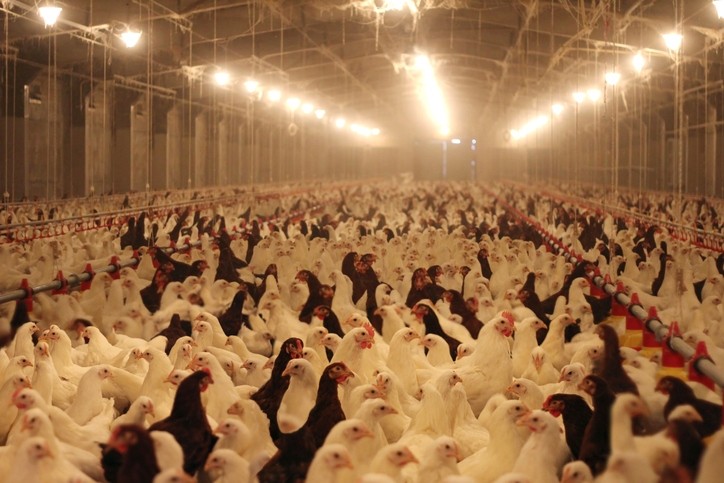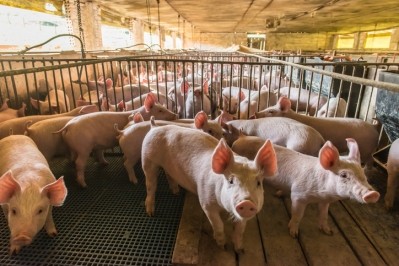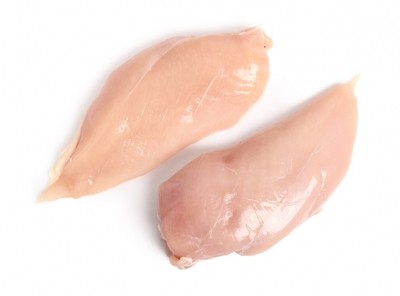Reports from IPPE
Superdosing phytase, reduced AA may support bird gain, feed conversion

We spoke with Craig Wyatt, AB Vista technical manager for North America, about research his team conducted examining the potential of ‘superdosing’ phytase in broiler diets at the International Production and Processing Expo (IPPE) in Atlanta last week. The enzyme degrades phytate.
“Phytate is a natural organic phosphorus that we find in all – mainly cereal grains – but all plant material has phytate and it is a way of storing phosphorus in the plant,” he told us. Initially it was thought to be inert, however, additional research discovered that the molecule has anti-nutritional properties, he added.
When an animal eats phytate it stimulates the production of mucus, which is comprised of amino acids, he said. “What happens is as we fed more phytate we saw amino acid digestibility go down, and as we fed phytase amino acid digestibility went back.”
Removing phytate from the diet reduces the overproduction of mucus and the bird has the ability to use dietary amino acids for growth, he said.
The feeding trial explored the effect that adding high levels of the phytate-targeting enzyme phytase to the diets of broiler chickens had on body weight, feed conversion ratio (FCR) and breast meat yield, the UK-based animal health company said.
The project looked at diets involving the supplementation of digestible amino acids at 100%, 95% and 90% of recommended feeding levels – and three amounts of phytase – 500, 1,500 and 3,000 units, the company said.
The feeding trial demonstrated that reducing dietary amino acids levels hindered bird performance and negatively influenced FCR, the company said. However, adding more phytase raised body weight initially and feeding 3,000 units provided performance and FCR improvements throughout the trial.
Details of the research trial also were published in the Journal of Applied Poultry Research.
Nutrition: phytate and phytase
Synthetic amino acids, inorganic phosphorus and energy are used in diets to meet the nutritional needs of poultry, the researchers said. Exogenous enzymes may be added to drop feed costs – the most commonly used enzymes is phytase as it allows for less inorganic phosphorus to be added and boosts growth performance.
Inositol hexaphosphate, or phytate, can be found in several mature cereal grains and oilseeds and comprises about two-thirds of the plant-stored phosphorus, they said. Phytate’s anti-nutritive properties include chelating essential minerals and phosphorus so the animal cannot digest them, inhibiting protein digestion and reducing amino acid digestibility.
Phytase is used to de-phosphorylate phytate, which releases phosphorus and other chelated minerals, they added.
Why superdose phytase?
On the molecule there are six attached phytates, said Wyatt. Removing more of them provides better access to inositol, which is absorbed by the chicken and is involved in different pathways, including acting as an energy source.
Removing one or two of the bound phytate does not remove all of the anti-nutritional properties, he said. “We actually need to get all the way to inositol to really eliminate it,” he added.
“What we found is we want to take that molecule and take all the phosphorus off,” he said. “It’s not anti-nutritional anymore and that gets absorbed and also it helps absorb the amino acids.”
When the inositol becomes available it moves into the blood and re-phosphorylates, he said. “We actually have phytate, but the only way to get phytate in our body we’ve got to go [through] inositol we can’t absorb intact phytates,” he added.
“Once it’s in the body, it’s an antioxidant so it very rapidly metabolizes so we find it in the brain, we find it in the heart, we find it in the liver, [and] kidney,” said Wyatt.
In other trials, researchers fed up to 4,000 and 5,000 units of phytase to try and remove as much phytate as possible, he said. There tends to be a “diminishing return” when larger amounts are used, but there is always a positive response.
Feeding trial overview
In the feeding trial, 2,520 birds were given one of nine corn- and soybean meal-based diets for a period of 44 days, the researchers said. A starter version of the diets was used on days 1-18, a grower diet on days 19-30 and a withdraw diet for days 31-44.
“The experimental design consisted of 3 levels of phytase at 500, 1,500, and 3,000 FTU/kg that were added into 3 levels of Cobb breeder recommended dAA densities at 100% (control), –5%, and –10% for a total of 9 dietary treatments,” they said. The diet with 500 FTU/kg phytase with the recommended level of digestible amino acids (dAA) was used to provide comparisons to the experimental feeds, they added.
Birds were weighed at the start and end of the trial and at each change in diet, they said. Average body weight and FCR were calculated.
At the end of the trial, a selection of birds was harvested to establish carcass weight and yield, the researchers said.
Results and financial implications
No interaction between phytase level and amino acid density was noted, the researchers said. Lowering amino acids reduced bird body weight at days 18, 30 and 44.
However, phytase level in the diet influenced body weight (BW), they said. By day 18, both phytase supplemented diets (1,500 FTU/kg and 3,000 FTU/kg) generated heavier birds compared to the control diet and at the conclusion, birds on the 3,000 FTU/kg diet were heavier and had an improved FCR.
“Reducing the amino acid density by 10% decreased BW on day 18 and 30 compared to the reference diet; however, increasing the level of phytase from 500 to 1,500 FTU/kg eliminated this negative impact of amino acid density,” they said.
The practice of superdosing phytase also can improve economic considerations in diet use, said Wyatt. In a poultry or swine diet, the highest cost is energy followed by amino acids and phosphorous.
“There are kind of two approaches,” he said of the economic implications for using more phytase in a diet. “You can grow a bigger bird and have less feed per pound of meat, or I can reduce the feed costs and have less cost per pound of meat.”
Depending on the desired outcome from the producer, they could use the results to either grow a larger bird using the same amount of feed or grow a bird of the same size with less feed, he added.
Source: The Journal of Applied Poultry Research
Title: Evaluation of Increasing Levels of Phytase in Diets Containing Variable Levels of Amino Acids on Male Broiler Performance and Processing Yields
Authors: K. Smith. C. Wyatt, J. Lee
DOI: https://doi.org/10.3382/japr/pfy065















